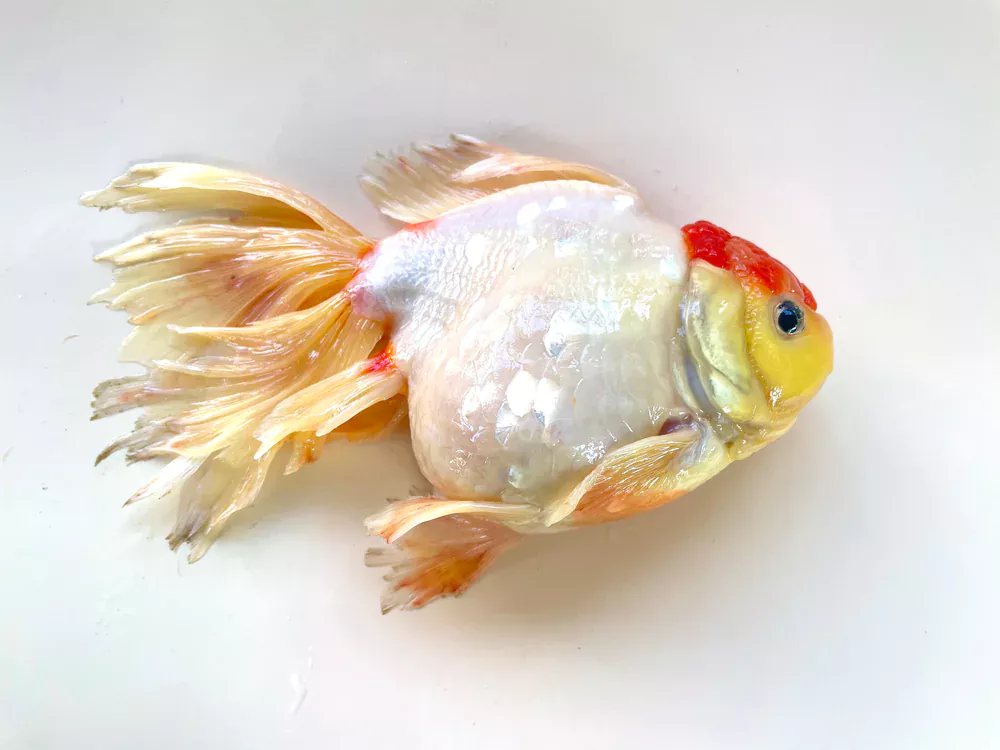Goldfish are water creatures and successful pets in so many ways, but when it comes to fin rot, it’s a different story. Many other varieties of fish can recover from fin rot within a few days or even weeks. But when it comes to goldfish, the situation is quite different. This is because they have fins that aren’t fully regenerative like others. So what can you do to help your goldfish recover from fin rot?
After spending months researching and testing, I’ve written the definitive guide for treating goldfish fin rot. I’m sharing all of my tips, tricks, and techniques so you can learn how to cure fin rot in your fish once and for all.
What Is Fin Rot Goldfish?
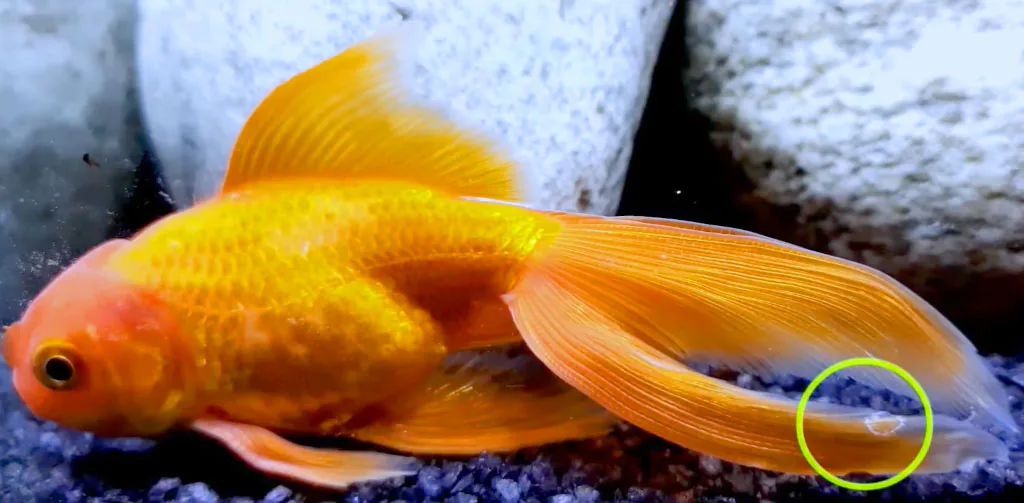
Fin rot is a common disease in goldfish caused by bacteria that infect the fins. It can be difficult to treat, especially if you don’t catch it early. It usually starts at the base of the tail or near the tail and spreads up toward the head. It begins as a small area of redness surrounded by white spots or lesions on the fins.
As it progresses, the redness spreads outward along the fin until it looks like many separate pieces of red thread scattered throughout the fin. The edges may start to peel away from the body, exposing raw flesh underneath. Fins can sometimes become so damaged that they fall off completely.
What Are The Goldfish Fin Rot Causes?
So you are wondering how do goldfish get fin rot? don’t worry I have listed all the possible causes of goldfish fin rot below. Just try your best to avoid them and you will be fine.
1- Bacterial Infection
Bacterial infection is the most common cause of fin rot in goldfish. It is caused by Mycobacterium marinum, which can be found in water and soil. A wound, such as a damaged fin or scale, can provide an entry point for the bacteria to enter the fish’s body.
2- Fin Rot From Fungus
Fungus is a secondary infection that grows on top of an already existing bacterial infection. The fungus grows out from the wound and attaches itself to surrounding tissue, causing more damage than just the original wound would have done without the fungus present.
3- Exposure to Ammonia and Nitrites
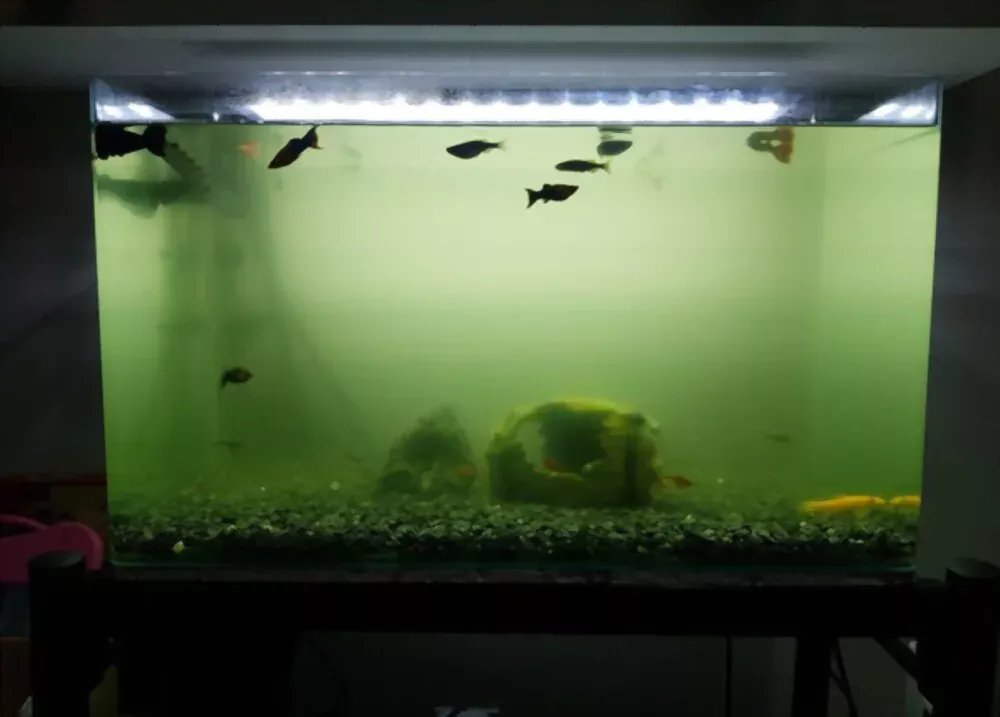
Ammonia is produced when fish waste breaks down in the aquarium, while nitrites are produced when ammonia breaks down. Both of these substances are highly toxic to fish, so it’s important to keep them out of your aquarium by maintaining good water conditions and keeping the tank properly filtered.
4- Stress In Fish
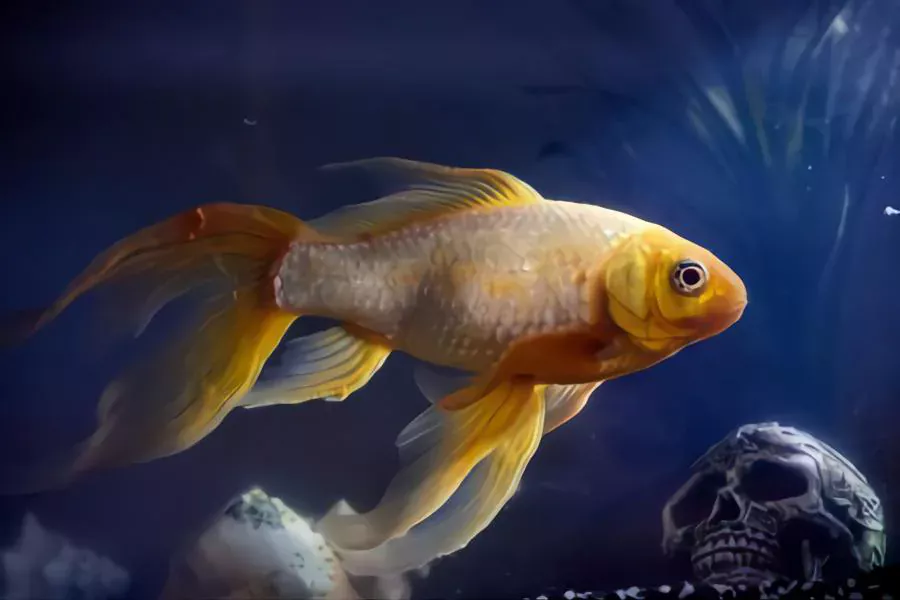
Fin rot can be caused by stress in goldfish. Stress in fish can come from many different kinds of stressors, including overcrowding, poor water quality, and low oxygen levels. If you notice your goldfish has fin rot and you can see it is stressed out (by observing how it acts), then chances are that this is the cause of its fin rot.
5- Immunocompromisation In Goldfish
Another cause of fin rot in goldfish is immunocompromisation. This occurs when there is an underlying disease or illness that leaves the fish unable to fight off the bacteria that causes fin rot. For example, if your goldfish has parasites or internal parasites (like ich), they will not be able to fight off any external bacteria which may infect them as well.
Symptoms of Fin Rot in Goldfish
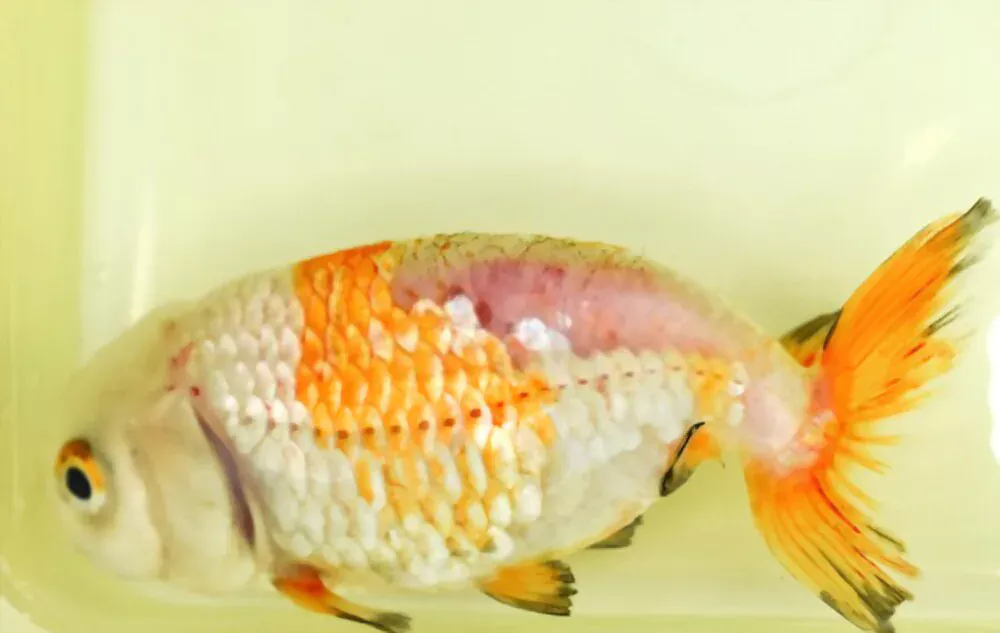
There are a number of different types of fin rot and each fish is affected slightly differently. However, there are some symptoms that you can watch out for.
1- Swollen Fin
The first sign is often swelling at the base of the fin where it meets the body. This can be a result of damage to the tissue and blood vessels from disease, injury, or parasites. In some cases, this swelling will spread along the entire length of the fin until it eventually falls off.
2- Swollen Body
If your goldfish has a swollen body, it could be due to fin rot. Fin rot causes inflammation in its body tissue. This causes swelling around its stomach area which may cause scales to fall off or appear pale in color.
3- Goldfish Will Become Lethargic
If your goldfish has fin rot, he will become lethargic and stop swimming around as much as he normally does. This is because his body is under attack from bacteria and other microbes that are causing his fins to rot away. When this happens, he may spend more time resting at the bottom of his tank than swimming around at the top with his friends.
4- Goldfish Will Stop Eating
As I mentioned earlier, Fin rot causes inflammation in the skin of your goldfish’s tail and fins, which makes them very sore and painful for him to move around on or even swim in his tank. Because it hurts so much for him to move around or swim, he may stop eating altogether because he doesn’t want to put any pressure on his sore fins by swimming or swimming against currents in his tank. If your goldfish stops eating for more than two days, then this can be related to fin rot.
5- Cloudy Eyes
Another symptom that may indicate that your goldfish has a fin rot is cloudy eyes; this can also be a symptom of bacterial eye infections in other species of fish as well as humans! However, If there are other fin rot symptoms found in the fish then this can be related to fin rot as well.
How to Prevent Fin Rot In Goldfish?
There are several ways to prevent fin rot in goldfish:
1- Keep Your Water Clean
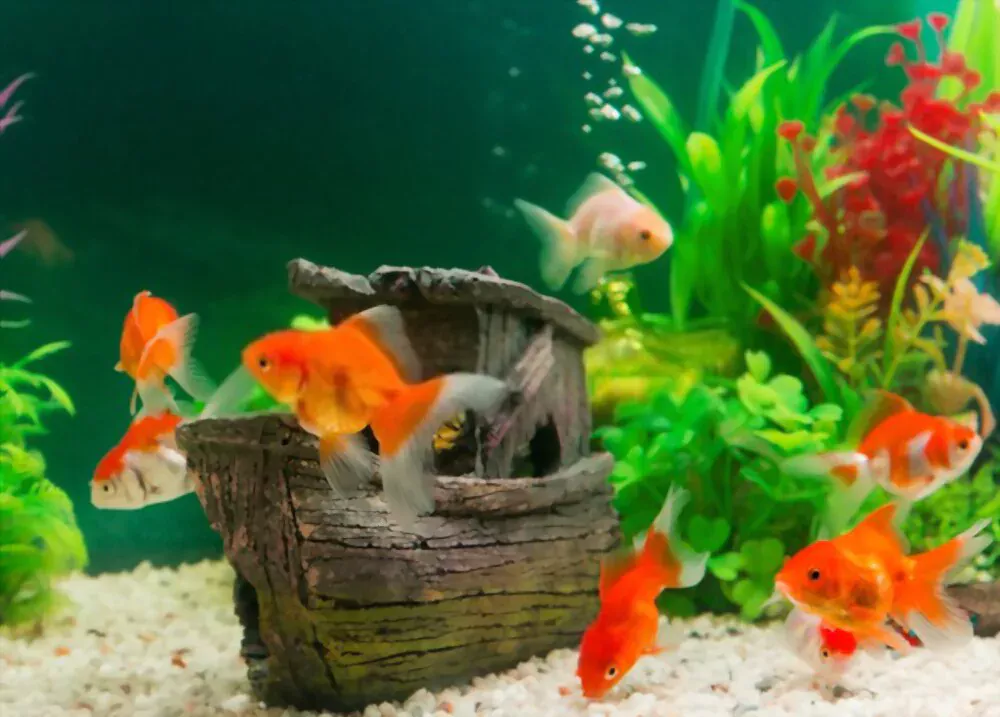
Clean water is one of the most important things when it comes to preventing fin rot in goldfish. If you have high nitrate levels, or if there are algae growing on any surfaces in your aquarium, then these factors can contribute to a buildup of bacteria that causes fin rot. You should change 30% of the water in your aquarium once per week, or more often if needed (such as during a large water change). You should also clean your filter regularly; this will ensure that there are no decaying particles left behind which could contribute to an outbreak of fin rot.
2- Avoid Overfeeding
Overfeeding is one of the main reasons for fin rot in goldfish. If your fish aren’t eating all of their food, try offering them smaller portions more frequently instead of large amounts less often. Avoid feeding your goldfish live foods if they’re not eating their regular pellets or flakes. Live foods can introduce parasites into your tank that may cause illness or stress to your fish, which can lead to fin rot. Goldfish don’t need live food to thrive in captivity!
3- Visually Inspect Your Goldfish
It is important to visually inspect your goldfish each day to ensure that they do not have any signs of fin rot. If you notice any abnormalities with their fins or body, then you should take them immediately to see a vet so they can be treated properly before it gets worse!
4- Keep The Tank Clean
As mentioned above, keeping the tank clean is a good way to prevent fin rot from occurring in the first place. However, if your pet does get sick, it’s important that you clean out as much toxic waste as possible so that he can heal properly without any further complications from bacteria build-up in his body (which may also lead to additional illness).
Treatment For Goldfish Fin Rot
Follow these steps to help your goldfish recover from fin rot:
1- Inspect the fins for signs of damage. The damage may appear to be white spots or rust-colored blotches along the edges of the fins or along the entire length.
2- Check the fish’s body for signs of injury, such as open wounds, bruises, or swelling on the body.
3- Clean your aquarium with a solution that contains aquarium salt and water conditioner (if you do not have aquarium salt, add one tablespoon per gallon of water). This will help restore bacteria balance in the tank and remove any dead tissue from your goldfish’s body so it doesn’t cause further damage to its skin and gills.
4- Put your fish in a quarantine tank until you are sure it is healthy again (at least two weeks). The quarantine tank should contain clean water and no other goldfish or other animals that could infect your pet with an illness or parasite.
5- Feed your fish a variety of foods including cooked peas, raw spinach, cooked carrots, cooked sweet potato, and cooked brown rice.
6- Increase aeration in your tank or pond by adding an air stone to your filter system or by adding additional aeration devices such as air pumps or air stones.
7- Use antibiotics or aquarium salt in your goldfish tank to help him/her recover from fin rot.
8- If you have followed these steps and they are not working then it’s time to visit the Vet.
Frequently Asked Questions (FAQs)
Is Goldfish Fin Rot Contagious?
The answer to this question is yes and no. Fin rot is not contagious in the sense that it can be spread from one fish to another. However, the bacteria that cause fin rot are bacterial and can spread from one tank of fish to another if the water is not properly treated or cleaned.
Does Fin Rot Kill Goldfish?
Goldfish fin rot is caused by Aeromonas salmonicida, a gram-negative rod-shaped bacterium that occurs naturally in freshwater environments. It is commonly found in rivers, lakes, and ponds but can also be found in aquariums containing goldfish. The bacteria live in the digestive tract of goldfish and reproduce rapidly when conditions are favorable for growth. If untreated, this infection can lead to anemia and death in affected goldfish.
Which Is The Best Medicine For Goldfish Fin Rot?
The best medicine for goldfish fin rot is the combination of Maracyn and ICH- X because these medicines treat infections quickly, safely, and effectively without damaging your fish’s delicate internal organs or removing oxygen from its water environment. ICH-X will not kill your fish if used as directed.
Which Is The Best Goldfish Fin Rot Antibiotics?
Maracyn Two (Minocycline) is the best goldfish fin rot antibiotics. This antibiotic treats bacterial infections in fish. Use this medication only if there is a bacterial infection present (e.g., cloudy eye). Do not use this medication if your fish has fungal infections or other secondary infections.
Few Final Words
Most cases of goldfish fin rot or tail rot can be easily cured by following the above steps. By doing this, you will have eliminated the possibility of systemic infections that may cause fin rot.
Just to be sure, it’s always best to consult with a specialist before treating your fish. This isn’t a recommendation or endorsement of any particular product, these are just a few options in tackling fin rot that has worked in my experience and that I’m sharing with the hope that it will help other fish owners as well.

